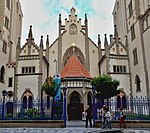Religion in the Czech Republic
Religion in the Czech Republic (2021)[1]
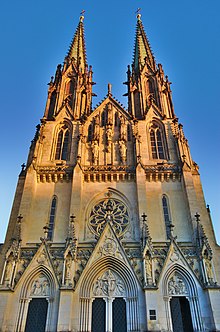
In the Czech Republic, 47.8% of population is
The
After the
Since the Battle of White Mountain, widespread
According to the official censuses conducted by the
Demographics
Census statistics, 1921–2021
| Religion | 1921 | 1930 | 1950 | 1991 | 2001 | 2011 | 2021 | |||||||
|---|---|---|---|---|---|---|---|---|---|---|---|---|---|---|
| Number | % | Number | % | Number | % | Number | % | Number | % | Number | % | Number | % | |
| Christianity | 9,150,872 | 91.5 | 9,691,392 | 90.8 | 8,332,458 | 93.7 | 4,518,512 | 43.9 | 3,094,227 | 30.2 | 1,379,802 | 13.2 | 1,241,214 | 11.7 |
| —Catholicism | 8,210,771 | 82.1 | 8,390,228 | 78.6 | 6,824,908 | 76.7 | 4,028,415 | 39.1 | 2,748,455 | 26.9 | 1,092,346 | 10.5 | 985,318 | 9.3 |
| ——Roman Catholic Church | 8,201,464 | 82.0 | 8,378,079 | 78.5 | 6,792,046 | 76.3 | 4,021,385 | 39.0 | 2,740,780 | 26.8 | 1,082,463 | 10.4 | 741,175 | 7.0 |
| ——Catholics without church | – | – | – | – | – | – | – | – | – | – | – | – | 235,834 | 2.2 |
| ——Ruthenian Greek Catholic Church | 9,307 | 0.1 | 12,149 | 0.1 | 32,862 | 0.4 | 7,030 | 0.1 | 7,675 | 0.1 | 9,883 | 0.1 | 8,309 | 0.1 |
| —Eastern Orthodox Church (majority Czech and Slovak) | 9,221 | 0.1 | 24,488 | 0.2 | 50,365 | 0.6 | 19,354 | 0.2 | 22,968 | 0.2 | 26,370 | 0.2 | 41,178 | 0.4 |
| —Evangelical Church of Czech Brethren | 231,199 | 2.3 | 290,994 | 2.7 | 401,729 | 4.5 | 203,996 | 2.0 | 117,212 | 1.1 | 51,858 | 0.5 | 32,577 | 0.3 |
| —Czechoslovak Hussite Church | 523,232 | 5.2 | 779,672 | 7.3 | 946,813 | 10.6 | 178,036 | 1.7 | 99,103 | 1.0 | 39,229 | 0.4 | 23,610 | 0.2 |
| —Jehovah's Witnesses | – | – | – | – | – | – | 14,575 | 0.1 | 23,162 | 0.2 | 13,069 | 0.1 | 13,298 | 0.1 |
| —Augsburg Confession Lutheran churches (majority Silesian) | 150,687 | 1.5 | 52,485 | 0.5 | 80,144 | 0.9 | 37,281 | 0.4 | 34,317 | 0.3 | 17,379 | 0.2 | 11,047 | 0.1 |
| —German Evangelical Church in Bohemia, Moravia and Silesia | – | – | 130,981 | 1.2 | 6,401 | 0.1 | – | – | – | – | – | – | – | – |
| —Old Catholic Church of the Czech Republic | 20,103 | 0.2 | 22,544 | 0.2 | – | – | 2,725 | 0.03 | 1,605 | 0.02 | 1,730 | 0.02 | 672 | 0.01 |
| —Other Christians[α] | 14,966 | 0.1 | 31,033 | 0.3 | 22,098 | 0.2 | 34,130 | 0.3 | 47,405 | 0.5 | 137,821 | 1.3 | 133,514 | 1.3 |
| Jediism | – | – | – | – | – | – | – | – | – | – | 15,070 | 0.1 | 21,539 | 0.2 |
| Buddhism | – | – | – | – | – | – | – | – | 6,817 | 0.07 | 6,101 | 0.06 | 5,757 | 0.05 |
| Islam | – | – | – | – | – | – | 495 | 0.0 | 3,699 | 0.04 | 3,358 | 0.03 | 5,244 | 0.05 |
Paganism |
– | – | – | – | – | – | – | – | – | – | 863 | 0.01 | 2,953 | 0.03 |
Pastafarianism |
– | – | – | – | – | – | – | – | – | – | – | – | 2,696 | 0.03 |
| Hinduism | – | – | – | – | – | – | – | – | 1,061 | 0.01 | 2,408 | 0.02 | 2,024 | 0.02 |
| Judaism | 125,083 | 1.3 | 117,551 | 1.1 | 8,038 | 0.1 | 1,292 | 0.01 | 1,515 | 0.01 | 1,474 | 0.01 | 1,901 | 0.02 |
Biotronics |
– | – | – | – | – | – | – | – | – | – | – | – | 1,053 | 0.01 |
| Other religion | 2,393 | 0.02 | 266 | 0.002 | 12,786 | 0.1 | 35,651 | 0.3 | 180,769 | 1.8 | 628 | 0.01 | 89,254 | 0.8 |
| Believers without religion | – | – | – | – | – | – | – | – | – | – | 760,316 | 7.3 | 1,005,788 | 9.6 |
| No religion | 716,515 | 7.2 | 834,144 | 7.8 | 519,962 | 5.8 | 4,112,864 | 39.9 | 6,039,991 | 59.0 | 3,604,095 | 34.5 | 5,027,794 | 47.8 |
| Not stated | 10,871 | 0.1 | 31,033 | 0.3 | 22,889 | 0.3 | 1,665,617 | 16.2 | 901,981 | 8.8 | 4,662,455 | 44.7 | 3,162,540 | 30.1 |
| Total population | 10,005,734 | 10,674,386 | 8,896,133 | 10,302,215 | 10,230,060 | 10,436,560 | 10,524,167 | |||||||
Line chart of the trends, 1921–2021
Census statistics 1921–2021:[1]
Graphs are unavailable due to technical issues. There is more info on Phabricator and on MediaWiki.org. |
Religions
Christianity
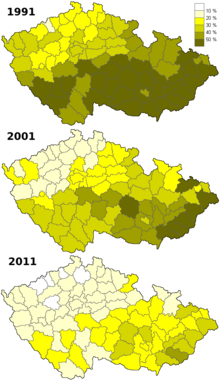
The
The
Roman Catholicism
From 1950 onwards, Marxist-Leninists gained power in Czechoslovakia, which from 1960 to 1989 became the Czechoslovak Socialist Republic, and while they fought all religions, Catholicism was targeted with particular aggressiveness.[6] After the Velvet Revolution in 1989 and the restoration of liberal democracy in the Czech lands, Catholicism, like other forms of Christianity, did not recover and continued to lose adherents.[6] The data from the national censuses show that Catholics decreased from 76.7% of the Czechs in 1950 prior to the Marxist-Leninist period, to 39.1% in 1991 after the fall of Marxism-Leninism, to 26.9% in 2001, to 10.5% in 2011, and to 9.3% in 2021.[1]
Protestantism

In the late 14th century, the religious and social reformer
After 1526, Bohemia came increasingly under the control of the
In 1918, when the Habsburg monarchy disintegrated and independent Czechoslovakia emerged, most of the Czechs professed formal affiliation to Catholicism; anti-Catholic sentiments spread quickly as Catholicism was viewed as the religion re-imposed by the Habsburg, so that in 1920 the
During the Marxist-Leninist years of the Czechoslovak Socialist Republic all religions were discouraged by the government; the Czech Protestant churches lost many members (the Czechoslovak Church lost 80% of its adherents), and they continued to decline after the restoration of liberal democracy after 1989.[6] Protestantism today constitutes a small minority of around 1% of the population; according to the 2021 census, only 0.2% of the Czechs (23,610) adhered to the Czechoslovak Hussite Church, 0.3% (32,577) adhered to the Evangelical Church of Czech Brethren, and 0.1% (11,047) were Lutherans of the Augsburg Confession (still mostly Silesian).[1] The Moravian Church, historically tied to the region of Moravia, was still present with a very small number of adherents, about 1,257.[1] Other Protestant minorities include Anglicans, Adventists, Apostolic Pentecostals, Baptists, Brethren, Methodists, and nondenominational Evangelicals.[1]
-
Typical countryside Hussite church of the 20th century in Jílové u Prahy, Central Bohemian Region
-
Church of the Conversion of Saint Paul, a historic centre of the Hussite Moravian Church in Brandýs nad Labem-Stará Boleslav, Central Bohemian Region
-
Evangelical Church of the Czech Brethren in Chodov, Prague
-
Church of Saint Joachim, a Lutheran church in Jáchymov, Karlovy Vary Region
-
Apostolic Pentecostal church in Brno, South Moravian Region
Orthodox Christianity, Jehovah's Witnesses and other Christians
In the 2021 census, 41,178 Czechs (0.4% of the population) identified themselves as adherents of the Eastern Orthodox Church, almost all of them members of the Orthodox Church of the Czech Lands and Slovakia and only a few hundreds of the Czech branch of the Russian Orthodox Church.[1] In the same census, 13,298 (0.1%) identified themselves as Jehovah's Witnesses, and very small minorities as Mormons of the Church of Jesus Christ of Latter-day Saints, adherents of the Unification Church, and of other minor Christian churches.[1] 71,089 Czechs (0.7%) identified themselves simply as "Christians".[1]
-
Cathedral of Saints Cyril and Methodius in Prague, the main church of the Czech and Slovak Orthodox Church
-
Orthodox Nunnery of Saints Wenceslaus and Ludmila in Loděnice, Central Bohemian Region
-
Kingdom hall of the Jehovah's Witnesses in Karviná, Moravian-Silesian Region
-
Mormon meetinghouse in Brno, South Moravian Region
Buddhism
In the 2021 census, 5,257 Czechs declared themselves adherents of
-
Hall of the Buddhist monastery Ārāma Karuṇā Sevena in Prostějov, Olomouc Region
-
Tibetan Buddhist shrine at the Prague Zoo
-
Tibetan Buddhist stupa in Spálené Poříčí, Plzeň Region
-
Vietnamese Buddhist hall in Plzeň
-
Mistress Bon Shim of the Kwan Um school of Korean Seon Buddhism
Paganism
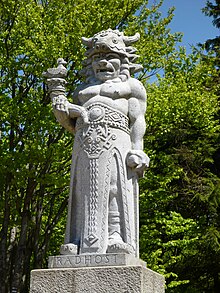
The entire Pagan community in the Czech Republic, including
The Community of Native Faith was among the government-recognised religious entities until 2010, when it was unregistered and became an informal association due to ideological disagreements between the Castists and other subgroups about whether Slavic religion was Indo-European hierarchic worship (supported by the Castists), Neolithic mother goddess worship, or neither.[20] The leader of the organisation since 2007 has been Richard Bigl (Khotebud), and it is today devoted to the celebration of annual holidays and individual rites of passage, to the restoration of sacred sites associated with Slavic deities, and to the dissemination of knowledge about Slavic spirituality in Czech society.[21] While the contemporary association is completely adogmatic and apolitical,[22] and refuses to "introduce a solid religious or organisational order" because of the past internal conflicts,[23] between 2000 and 2010 it had a complex structure,[22] and redacted a Code of Native Faith defining a precise doctrine for Czech Rodnovery (which firmly rejected the Book of Veles).[24] Though Rodná Víra no longer maintains structured territorial groups, it is supported by individual adherents scattered throughout the Czech Republic.[25]
-
Rodnover idols in Břeclav, South Moravian Region
-
Rodnover idol at a park in Kovářov, South Bohemian Region
-
Altar dedicated to the god Thoth by a Czech practitioner of Kemetism
Other religions
The deep changes in the religious sensibility of the Czechs since the early 20th century, and the loss of religious monopoly and decline of Christianity, opened a space for the growth of new forms of religiousness,[9] including ideas and non-institutional, diffuse models similar to those of Eastern religions,[26] with the spread of movements centred around various gurus, and hermetic and mystical paths.[11]
In the 2021 census, 21,539 Czechs (0.2% of the population) identified themselves as adherents of
-
Mosque of Brno, South Moravian Region
-
Hindu altar at the Prague Zoo.
-
Maisel Synagogue in Prague
-
Practitioners of Falun Gong in Prague
Irreligious people
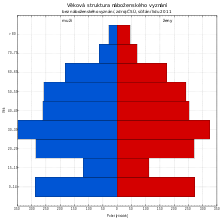
In the 2021 census, 5,027,794 Czechs, corresponding to 47.8% of the total population of the Czech Republic, identified themselves as irreligious, including atheism, agnosticism and other irreligious life stances.[1] Some Czech atheists have organised themselves in the Civic Association of Atheists (Občanské sdružení ateistů), which is a member of the Atheist Alliance International.[29] Not all irreligious Czechs are atheists; a number of non-religious people believe or practise unorganised forms of spirituality which do not require strict adherence or identification, similar to Eastern religions.[26]
Freedom of religion
In 2023, the country was scored 3 out of 4 for religious freedom.[30]
See also
![]() Media related to Religion in the Czech Republic at Wikimedia Commons
Media related to Religion in the Czech Republic at Wikimedia Commons
Notes
- ^ "Other Christians" in the census include people who declared themselves simply "Christians" without denomination, as well as Anglicans, Adventists, Apostolic Pentecostals, Baptists, Brethren, Methodists, Mormons, Moravian Hussites, Unificationists, and nondenominational Evangelicals.
References
Citations
- ^ a b c d e f g h i j k l m n o p q r s t u v w x Official census data from the Czech Statistical Office:
- "Obyvatelstvo podle náboženského vyznání a pohlaví podle výsledků sčítání lidu v letech 1921, 1930, 1950, 1991 a 2001" [Population by denomination and sex: as measured by 1921, 1930, 1950, 1991 and 2001 censuses] (PDF). Archived from the original (PDF) on 21 February 2011.
- "Obyvatelstvo podle náboženské víry a pohlaví podle výsledků sčítání lidu v letech 1921, 1930, 1950, 1991, 2001 a 2011" [Population by religious belief and sex by 1921, 1930, 1950, 1991, 2001 and 2011 censuses]. Archived from the original on 21 January 2022.
- "2011 Census: Population by religious belief and by regions" (PDF). Archived from the original (PDF) on 4 November 2013.
- "2011 Census: Population by religious belief and by municipality size groups" (PDF). Archived from the original (PDF) on 21 February 2015.
- "Obyvatelstvo podle náboženské víry v letech 1991 až 2021" [Population by religious beliefs from 1991 to 2021]. Archived from the original on 22 January 2022.
- "2021 Census: Population by religious belief and by regions". Archived from the original on 21 January 2022.
- ^ Spousta 2002, pp. 345, 362.
- ^ Spousta 2002, pp. 345–346, 348, 358.
- ^ a b c d e f g h i j k l Spousta 2002, p. 346.
- ^ Staar 1982, p. 90.
- ^ a b c d Spousta 2002, p. 347.
- ^ Spousta 2002, pp. 346–347.
- ^ a b c Spousta 2002, p. 345.
- ^ a b c Spousta 2002, p. 350.
- ^ Spousta 2002, p. 355.
- ^ a b Spousta 2002, p. 348.
- ^ "World Buddhist Directory – Czech Republic". Buddhanet. Archived from the original on 26 January 2022.
- ^ Mačuda 2014, p. 102, note 3.
- ^ Dostálová 2013, p. 179.
- ^ Mačuda 2014, p. 101.
- ^ Mačuda 2014, p. 102.
- ^ "Občanské sdružení Tartaria". Archived from the original on 28 August 2021.
- ^ "Wicca.cz – Tradiční iniciační Wicca v České republice". Archived from the original on 23 January 2022.
- ^ "Per Kemet – stránki o Kemetismu". Archived from the original on 24 May 2021.
- ^ Mačuda 2014, p. 103; Maiello 2015, p. 86; Maiello 2018, passim.
- ^ Mačuda 2014, p. 103.
- ^ a b Mačuda 2014, p. 104.
- ^ Mačuda 2014, p. 107.
- ^ Mačuda 2014, p. 106.
- ^ Mačuda 2014, p. 105.
- ^ a b Spousta 2002, pp. 345–346, 358, 362.
- ^ "Jediismus.cz". Archived from the original on 27 March 2021.
- ^ "Společenství Josefa Zezulky". Archived from the original on 23 January 2022.
- ^ "Ateisté ČR". Archived from the original on 17 December 2021.
- ^ Freedom House website, retrieved 2023-08-08
Sources
- Dostálová, Anna-Marie (2013). "Czech Neopagan Movements and Leaders". In Kaarina Aitamurto; Scott Simpson (eds.). Modern Pagan and Native Faith Movements in Central and Eastern Europe. Durham: Acumen. pp. 164–181. ISBN 9781844656622.
- Mačuda, Jiří (2014). "Чешская община 'Родная вера' – возвращение к духовности предков" [The Czech community 'Rodná víra' – a return to the spirituality of the ancestors]. Colloquium Heptaplomeres (in Russian). I. Nizhny Novgorod: Minin University: 101–109. ISSN 2312-1696.
- Maiello, Giuseppe (2015). "Родноверие в Чехии в 1998–2005 годах: первый этап или последний?" [Rodnovery in Czechia in 1998–2005: The first stage or the last?]. Colloquium Heptaplomeres (in Russian). II. Nizhny Novgorod: Minin University: 83–88. ISSN 2312-1696.
- ——— (2018). "On the Agony of Czech Slavic Paganism and the Representation of One's Own Funeral among Contemporary Czech Pagans". The Pomegranate: The International Journal of Pagan Studies. 20 (2): 137–156. .
- Spousta, Jan (2002). "Changes in Religious Values in the Czech Republic" (PDF). Czech Sociological Review. 38 (3): 345–363. doi:10.13060/00380288.2002.38.3.06. Archived from the original(PDF) on 1 November 2021.
- Vogel, Jiří (2017). "The Decline of Churches in the Czech Republic and the Question of Social Identity". Danubius. XXXV: 437–454.
- Staar, Richard Felix (1982). Communist Regimes in Eastern Europe. Hoover Institution Press. ISBN 9780817976927.




















